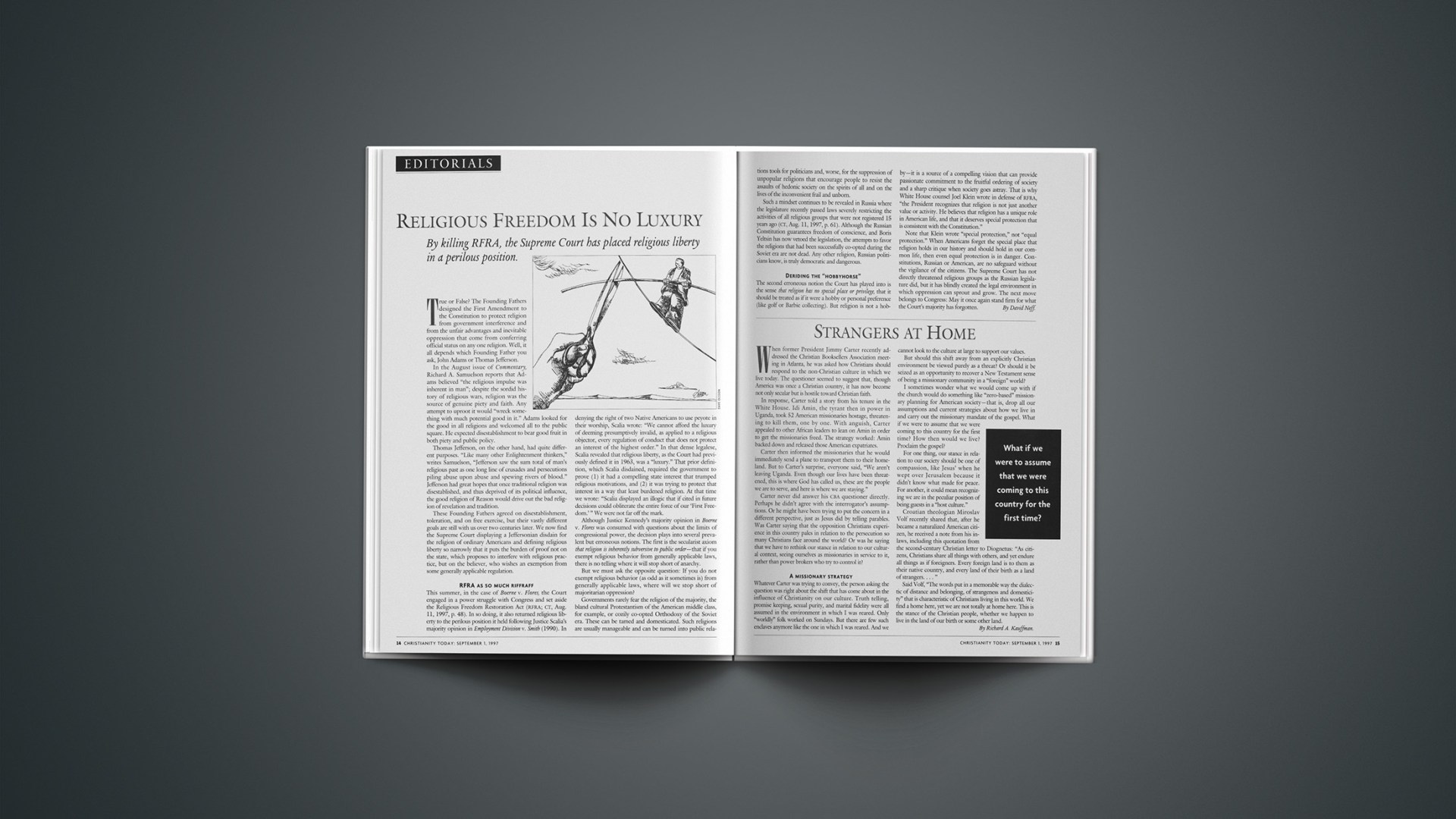True or False? The Founding Fathers designed the First Amendment to the Constitution to protect religion from government interference and from the unfair advantages and inevitable oppression that come from conferring official status on any one religion. Well, it all depends which Founding Father you ask, John Adams or Thomas Jefferson.
In the August issue of Commentary, Richard A. Samuelson reports that Adams believed "the religious impulse was inherent in man"; despite the sordid history of religious wars, religion was the source of genuine piety and faith. Any attempt to uproot it would "wreck something with much potential good in it." Adams looked for the good in all religions and welcomed all to the public square. He expected disestablishment to bear good fruit in both piety and public policy.
Thomas Jefferson, on the other hand, had quite different purposes. "Like many other Enlightenment thinkers," writes Samuelson, "Jefferson saw the sum total of man's religious past as one long line of crusades and persecutions piling abuse upon abuse and spewing rivers of blood." Jefferson had great hopes that once traditional religion was disestablished, and thus deprived of its political influence, the good religion of Reason would drive out the bad religion of revelation and tradition.
These Founding Fathers agreed on disestablishment, toleration, and on free exercise, but their vastly different goals are still with us over two centuries later. We now find the Supreme Court displaying a Jeffersonian disdain for the religion of ordinary Americans and defining religious liberty so narrowly that it puts the burden of proof not on the state, which proposes to interfere with religious practice, but on the believer, who wishes an exemption from some generally applicable regulation.
RFRA as so much riffraff This summer, in the case of Boerne v. Flores, the Court engaged in a power struggle with Congress and set aside the Religious Freedom Restoration Act (RFRA; CT, Aug. 11, 1997, p. 48). In so doing, it also returned religious liberty to the perilous position it held following Justice Scalia's majority opinion in Employment Division v. Smith (1990). In denying the right of two Native Americans to use peyote in their worship, Scalia wrote: "We cannot afford the luxury of deeming presumptively invalid, as applied to a religious objector, every regulation of conduct that does not protect an interest of the highest order." In that dense legalese, Scalia revealed that religious liberty, as the Court had previously defined it in 1963, was a "luxury." That prior definition, which Scalia disdained, required the government to prove (1) it had a compelling state interest that trumped religious motivations, and (2) it was trying to protect that interest in a way that least burdened religion. At that time we wrote: "Scalia displayed an illogic that if cited in future decisions could obliterate the entire force of our 'First Freedom.' " We were not far off the mark.
Although Justice Kennedy's majority opinion in Boerne v. Flores was consumed with questions about the limits of congressional power, the decision plays into several prevalent but erroneous notions. The first is the secularist axiom that religion is inherently subversive to public order—that if you exempt religious behavior from generally applicable laws, there is no telling where it will stop short of anarchy.
But we must ask the opposite question: If you do not exempt religious behavior (as odd as it sometimes is) from generally applicable laws, where will we stop short of majoritarian oppression?
Governments rarely fear the religion of the majority, the bland cultural Protestantism of the American middle class, for example, or cozily co-opted Orthodoxy of the Soviet era. These can be tamed and domesticated. Such religions are usually manageable and can be turned into public relations tools for politicians and, worse, for the suppression of unpopular religions that encourage people to resist the assaults of hedonic society on the spirits of all and on the lives of the inconvenient frail and unborn.
Such a mindset continues to be revealed in Russia where the legislature recently passed laws severely restricting the activities of all religious groups that were not registered 15 years ago (CT, Aug. 11, 1997, p. 61). Although the Russian Constitution guarantees freedom of conscience, and Boris Yeltsin has now vetoed the legislation, the attempts to favor the religions that had been successfully co-opted during the Soviet era are not dead. Any other religion, Russian politicians know, is truly democratic and dangerous.
Deriding the "hobbyhorse" The second erroneous notion the Court has played into is the sense that religion has no special place or privilege, that it should be treated as if it were a hobby or personal preference (like golf or Barbie collecting). But religion is not a hobby—it is a source of a compelling vision that can provide passionate commitment to the fruitful ordering of society and a sharp critique when society goes astray. That is why White House counsel Joel Klein wrote in defense of RFRA, "the President recognizes that religion is not just another value or activity. He believes that religion has a unique role in American life, and that it deserves special protection that is consistent with the Constitution."
Note that Klein wrote "special protection," not "equal protection." When Americans forget the special place that religion holds in our history and should hold in our common life, then even equal protection is in danger. Constitutions, Russian or American, are no safeguard without the vigilance of the citizens. The Supreme Court has not directly threatened religious groups as the Russian legislature did, but it has blindly created the legal environment in which oppression can sprout and grow. The next move belongs to Congress: May it once again stand firm for what the Court's majority has forgotten.
Copyright © 1997 Christianity Today. Click for reprint information.










